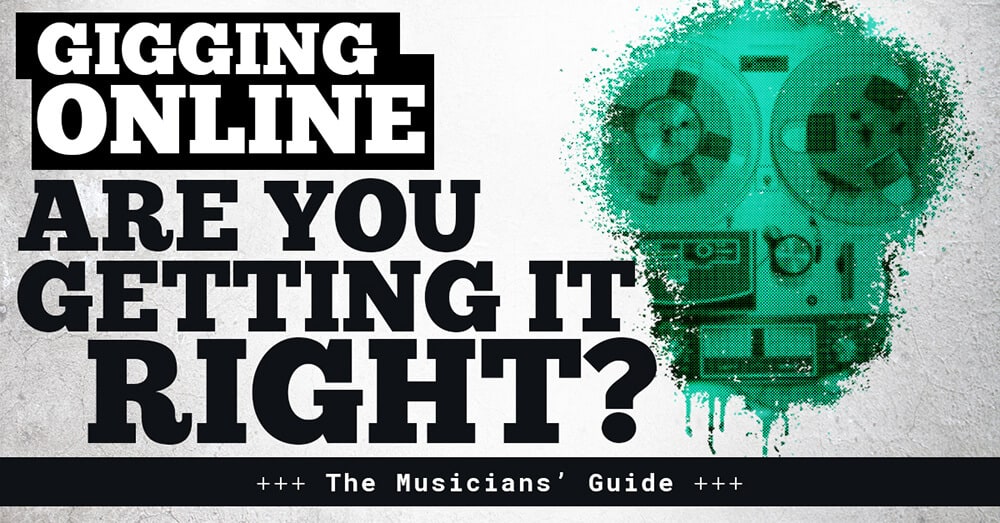JOIN US SEPTEMBER 2024 - APPLY TODAY OR BOOK YOUR PLACE ON ONE OF OUR OPEN DAYS IN BRIGHTON OR SHEFFIELD. UCAS CLEARING IS NOW OPEN.
JOIN US SEPTEMBER 2024 - APPLY TODAY OR BOOK YOUR PLACE ON ONE OF OUR OPEN DAYS IN BRIGHTON OR SHEFFIELD. UCAS CLEARING IS NOW OPEN.

Music has always been at the forefront of social interaction. From the moment you start learning your chosen instrument, singing songs at school or jamming with your friends, music becomes the glue that brings people together.
But what if you can’t meet up with your band mates? What if the audience can’t come to you?
All is not lost. Welcome to the world of remote gigging, jamming and collaborating. Let me lead you through some of the things I’ve learnt while being a musician online and give you tips to help make your remote musical career a success.
The thought of playing live over the internet is a daunting prospect, especially if you’re used to the traditional way of gigging in venues.
However, there are a lot of similarities between the two. The more you think about your live stream as an event, the more you and your audience will get out of it.
Something that won’t change much is the promotional side – you still must advertise any remote gig beforehand. Message your friends, create virtual gig posters and post on social media with plenty of time for people to plan their lives around seeing your show. An added advantage of remote gigging is that your audience don’t have to plan transport to the show or put aside large amounts of time.
I have actually had people watch me play online who wouldn’t normally be able to see me play live, so you can really use this to your advantage. The audience may be more diverse due to them being in another country or perhaps they are socially anxious in crowds.
Before even thinking about doing a virtual gig you need to address whether you can.
I like to think of it as a remote soundcheck. Whilst planning any show, the main priority should be the audience end-user experience. For them to stay watching and engaged you need to give them as high a quality audio as you can.
That’s not to say you need to go out and spend lots of money on expensive equipment. It could be as simple as making sure the microphone on your camera is in the right position if you’re streaming from your phone or making sure the levels are correct if you’re performing along to a pre-recorded track.
Quite often your chosen social media platform is able to stream to just you. Use this feature to experiment with set ups before actually going live to an audience. You can ask friends and other musicians to critique the quality too, as it’s quite easy to get caught up in one aspect and miss something glaringly obvious.
One thing I see time and time again when watching online shows is the lack of thought put into lighting and camera angles. This is just as important as the sound quality. Nobody wants to see you perform with your head half out of frame, your instrument too dark to see, and your dirty washing on the floor in the background.
Let’s start with where you are performing from. If you are live streaming from your home, choose a room that is clutter free so that your audience can focus on you, not what’s going on in the background. Make sure the camera you are using is in focus, is framing you as a performer and all cabling is out of sight. Even if you haven’t got too much space, a clever camera angle can draw in the audience while hiding the fact that you may be playing in your bedroom.
Finally, don’t forget about lighting. Much in the same way a traditional gig would be lit to enhance the performance, your remote gig needs to do the same.
In an ideal world I’d recommend investing in some specialist lighting equipment with adjustable dimmers so you can adjust the light levels. However, some carefully placed lamps can do wonders in creating a mood. Remember, too little light and your audience won’t be able to see you properly. Too much light and you’ll look washed out on screen.
As you’ll be streaming your gig, you won’t be charging a ticket per se. But that doesn’t mean you can’t use it as a revenue stream. Don’t be put off asking for donations both before, during and after your show. I like to think of it as the virtual tip jar.
Many streaming services allow you to link directly to PayPal for your audience to show their appreciation. Also, if you have merchandise to sell let people know about it.
Sharing a link to your merch in between songs can work wonders in bringing in revenue as your audience see it as an alternative to paying a ticket price.
Remember, even though you may not be getting a gig fee like you would do on a normal show there are no overheads (such as venue hire, transport costs etc) so any money you do make is pure profit.
What if you want to jam and collaborate with other musicians remotely in real time? That’s where things start to get a bit trickier but with a change in mindset your creativity can flow even though you are miles apart.
Even with all the technological advancements of the past few years you’ll eventually meet the terrors of latency and slow internet speeds.
Latency is the delay between playing a note on your end and the person you are collaborating with hearing it their end. When you are playing a live streaming show this problem wont particularly matter as you aren’t having to play along with other musicians in another location. Plus, even if your audience hears your audio slightly later than you, they’re still hearing everything in time.
However, if you try playing along to say a drummer while you are playing guitar over the internet then that latency means you are out of time with each other, making live remote jamming impossible in the traditional sense.
The main culprit of this is slow internet speeds. The UK is notorious for slow upload speeds, meaning there will be a delay between you playing a note, it being uploaded to the internet and it being download by the other musician.
If you can’t play together in real time, then what are your options? Well I like to do a half and half approach. Have a live webchat or video conferencing call open between you while writing and bounce ideas between you. That way you can piece bits of a song together in stages and if you record your video call, you’ll never have that “What was that riff I just played?” moment ever again!
Prepare any ideas you do have beforehand and send them to your fellow musicians. It gives them a chance to think about their own parts to contribute and I’ve found this approach is actually more likely to produce new ideas away from the distractions of the rehearsal space.
The same approach can be applied to being a session musician and playing on other artists work. The majority of my session work is conducted from my small home studio, with the producer listening in to my performances while I record them my end. They can then give active feedback on what they would like from me and I can send them over the session files after, ready for them to mix and master.
As I mentioned, this doesn’t mean you have to go out and spend lots of money. However, prioritising your spending on a few key areas can mean a huge jump in quality for both your audience and your fellow musicians.
Here’s my top 5 things to spend your hard-earned cash on:
The main cause of problems when streaming. If you can invest in a quick broadband or fibre optic internet connection with at least 10mbps it will make all the difference. Remember the faster the better.
A higher quality microphone, either via USB or through a recording interface, will be a big step up in clarity compared to your phone or laptop built-in microphone. Your audience needs to hear you clearly, otherwise they’ll just find something else to occupy their time.
Even a few inexpensive photography lights placed in key places will make any livestream look professional. Also think about adding some fairy lights to your background or a backdrop of some sort. It could be something as simple as a hung-up sheet, but it’ll make all the difference.
A good webcam, action cam (e.g. GoPro) or small DSLR camera attached to your laptop will have an immediate impact on your video quality. Make sure it can capture at least 1080p. Anything less starts to look grainy or fuzzy. If you’re streaming on your phone perhaps invest in some lenses to go over your phone camera to give a more cinematic, less harsh feel to your shots.
A strange thing to invest in I know but a few hours spent looking up other people’s livestreams, watching video tutorials and optimising your broadcasting settings will mean your performance is less likely to be plagued by technical difficulties. Practice a livestream beforehand to make sure everything works and that you can be seen and heard.
I hope you can make use of a few of these tips and that they help you avoid the potential pitfalls of remote streaming. I look forward to seeing you at your gig very soon, virtually.
If you interested in learning more and are serious about progressing in your career as a musician, Order a Prospectus or Apply Now.

- ‘Water bear’ is the common name for a Tardigrade.
- Tardigrades are micro creatures, found everywhere on earth.
- They are the most resilient creatures known.
- They can survive and adapt to their surroundings, even in outer space.
- Their resilience and ability to adapt and survive inspires us in everything we do. We love them.


WaterBear Education Ltd, Hanover House,
118 Queens Road, Brighton BN1 3XG, UK Map
Email: [email protected]
Tel: +44 (0) 1273 726230
WaterBear Sheffield, Unit 4, Gatecrasher,
49 Eyre Lane, Sheffield S1 4RB, UK
Email: [email protected]
Tel: +44 (0) 1143 992720

WaterBear Education Ltd, Hanover House,
118 Queens Road, Brighton BN1 3XG, UK Map
Email: [email protected]
Tel: +44 (0) 1273 726230
WaterBear Sheffield, Unit 4, Gatecrasher,
49 Eyre Lane, Sheffield S1 4RB, UK
Email: [email protected]
Tel: +44 (0) 1143 992720
- ‘Water bear’ is the common name for a Tardigrade.
- Tardigrades are micro creatures, found everywhere on earth.
- They are the most resilient creatures known.
- They can survive and adapt to their surroundings, even in outer space.
- Their resilience and ability to adapt and survive inspires us in everything we do. We love them.
